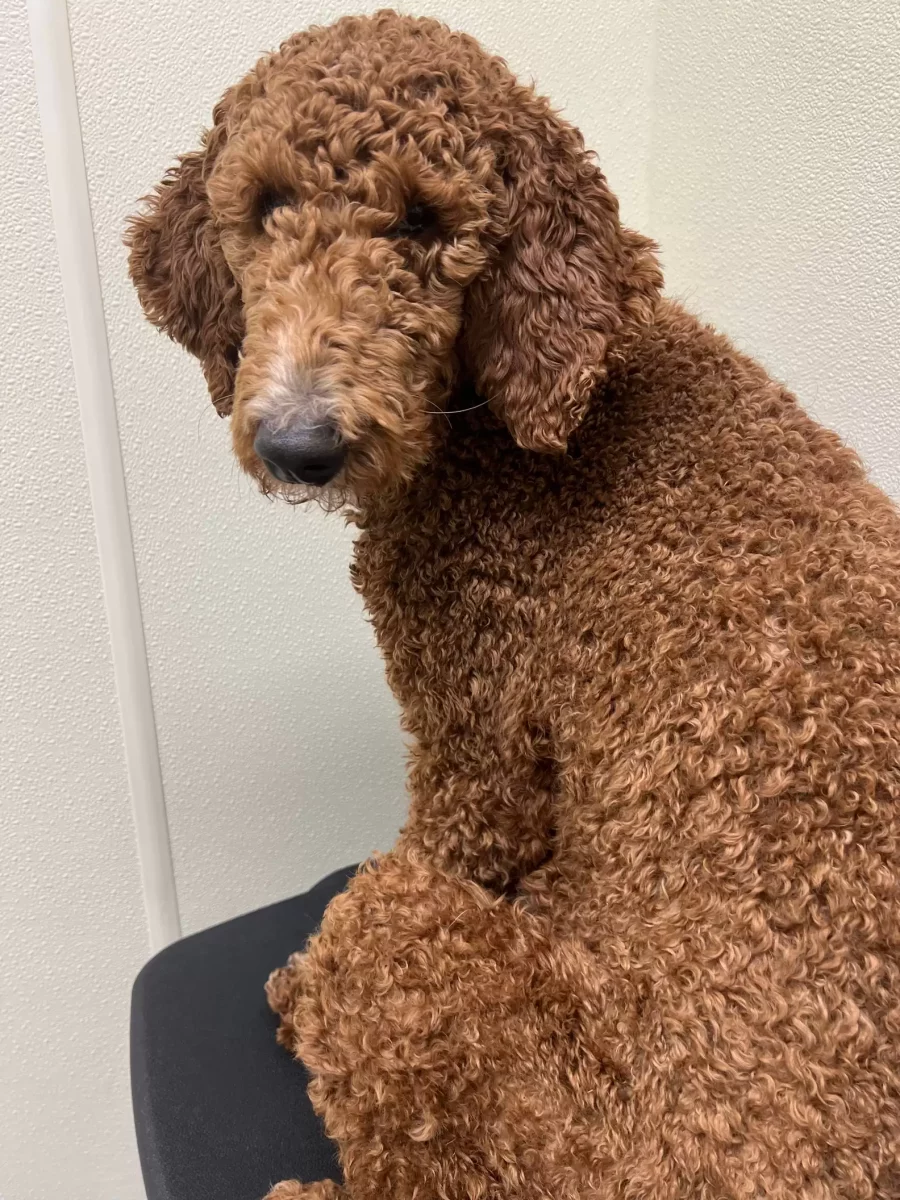Fostering a puppy is a special kind of kindness. For people to accept stray or abandoned dogs in their homes and help them recover from the emotional turmoil they had to deal with is just a heroic act.
So many of these dogs desperately need a new, fresh start, and until they can get one, a foster parent is there every step of the way to make sure they heal up and get ready to step into their forever home.
In this story, we will talk about a dog who has gone through so much, but also had another surprise on the way that nobody knew about.
A New Foster Family

When she first agreed to foster a dog, Kaitlin Devoto didn’t know much. In fact, she knew nothing at all.
She said for the Dodo: I didn’t know the gender or age. The first time we knew what she looked like was when she arrived in Cincinnati when I picked her up.
When she was at the pickup centre in New York, she saw the most beautiful red poodle. She noticed that the dog might have been producing milk, but assumed it was probably due to a litter.
She continued by saying: It’s not unusual to receive a puppy mill Momma who’s still lactating. When their puppies are weaned, moms are ‘no longer useful’.
The dog also seemed like it had been starving for a long time, but Devoto has a very nutritious solution for that. She grabbed the poodle and took her home.
Adorable Little Surprise

Four days after she took the dog into foster care, she was awoken by something unusual. She came to the dog and realized there was a small puppy in the dog bed.
She delivered him over the night and Devoto was completely oblivious to the fact it happened.
She checked to see if there were any more puppies on the way, but it turned out that it was just that one.
Devoto knew she had to act fast, so she did her best to make sure the momma and her baby were comfortable. She took a few comfortable blankets and placed them next to the dogs.
When she examined the new puppy, he was male and resembled a chicken nugget; hence, the reason for his new name.
The woman said: He was very quickly named Chicky Nug. But I was stumped on a name for Momma that fit the same theme.
Now, all she had to do was name his mom, and it had to fit the new theme, so she was called Mickey D.
An Exciting New Future

Time has gone by and the newborn puppy has now grown quite a bit and is very playful. Devoto said: He loves to run around and do zoomies. And he’s very interested in biting toes and toys.
Mickey also loves playing with her new toys, and apparently, her shy attitude is dwindling and she is becoming more outgoing as time goes on.
Currently, the dog family is still with Devoto and is enjoying their stay there. However, soon, they will go with a new family to their forever homes. The dogs will go through a standard adoption process with the help of Louie’s Legacy Animal Rescue in New York.
It’s unclear if they found their new families, but there is no doubt in my mind that someone will want to adopt such adorable dogs.
Ever noticed your furry friend trembling for no apparent reason? It’s a common sight that can leave you wondering. Dogs, with their wagging tails and playful antics, can sometimes exhibit trembling behavior that might catch you off guard. As an experienced dog trainer, you’ve likely encountered this phenomenon and understand that there can be various reasons behind it. From excitement to anxiety, a dog’s trembling can signal a range of emotions that they might not express in words.
Understanding why dogs tremble is a key aspect of caring for your canine companion. It’s essential to decipher the underlying causes behind this behavior to ensure your furry friend’s well-being and happiness. So, let’s take a closer look at the possible factors that could be making your dog tremble and how you can support them through it.
Understanding Dog Trembling
The Basics of Canine Behavior
Understanding dog trembling starts with knowing the basics of canine behavior. Dogs communicate through body language, and trembling is a common way for them to express their emotions. It can be a response to different stimuli, including excitement, fear, cold, or illness. By recognizing these cues, you can better understand your furry friend’s feelings.
How Trembling Differs From Other Behaviors
It’s essential to understand how trembling differs from other behaviors in dogs. While trembling can signal excitement or fear, it’s crucial to observe the context in which it occurs. Unlike shivering due to cold, trembling associated with emotions like anxiety may require a different approach. Knowing these distinctions can help you provide the right support and care for your beloved pet.
Common Reasons Why Dogs Tremble
Feeling Cold
When your dog is shivering or trembling, one common reason could be that they are feeling cold. Just like us, dogs can feel cold too, especially in chilly weather or if they are in a cold environment. If you notice your pup trembling and they are not ill or anxious, providing them with a warm blanket or adjusting the room temperature can help keep them cozy.
Excitement or Anticipation
Dogs love to show their excitement, and one way they do this is by trembling when they are thrilled or anticipating something fun. Whether it’s a tasty treat, a game of fetch, or a walk in the park, your furry friend’s trembling could be a sign of their eagerness and joy. It’s their way of expressing their excitement and happiness in the moment.
Stress and Anxiety
Just like humans, dogs can experience stress and anxiety, leading to trembling as a physical manifestation of their emotions. If your dog is trembling due to stress or anxiety, it’s essential to identify the triggers causing these feelings. Common stressors for dogs include loud noises, new environments, separation anxiety, or changes in their routine. Providing a safe and comforting environment can help alleviate their stress and reduce trembling.
Pain or Illness
Trembling in dogs can also be a sign of pain or illness. If your dog is trembling persistently or in a way that seems unusual, it’s crucial to monitor their behavior for other signs of discomfort or illness. Pain-related trembling can indicate underlying health issues that require veterinary attention. Keep an eye out for any additional symptoms, such as lethargy, loss of appetite, or limping, and consult your veterinarian if you have concerns about your dog’s health.
Remember, understanding why your dog is trembling is essential for their well-being. By recognizing the common reasons behind this behavior, you can provide the necessary support and care to ensure your furry companion is happy and healthy.
Medical Conditions Associated With Trembling in Dogs
Generalized Tremor Syndrome
Generalized Tremor Syndrome, also known as White Dog Shaker Syndrome, mostly affects small, white dogs. It leads to full-body tremors, especially when these dogs are stressed or excited. While the exact cause is unknown, it’s believed to be related to the cerebellum in the brain. This condition can be managed with proper veterinary care and medication.
Poisoning or Toxicity
Dogs can start trembling if they’ve ingested something toxic or poisonous. Common symptoms include shaking, vomiting, weakness, and even seizures. It’s crucial to seek immediate veterinary help if you suspect your dog has encountered a toxic substance. Treatment will depend on the toxin ingested and its effects on your furry companion’s health.
Neurological Disorders
Neurological disorders in dogs can also lead to trembling. Issues like epilepsy, encephalitis, or brain tumors can cause involuntary tremors in dogs. These conditions require a thorough diagnosis by a veterinarian to determine the underlying cause of the tremors. Treatment will vary depending on the specific neurological disorder affecting your pet.
Remember, if you notice persistent trembling in your dog, it’s essential to consult a veterinarian for a proper diagnosis and tailored treatment plan. Understanding the potential medical conditions associated with trembling can help you provide the necessary care and support to keep your beloved pet healthy and happy.
How to Respond to a Trembling Dog
Assessing the Situation
When you notice your dog trembling, the first step is to assess the situation calmly. Check for any immediate threats or dangers in the surrounding environment that could be causing your pet distress. Look for signs of shivering, fear, or unusual behavior that may indicate the reason behind the trembling.
Providing Comfort and Safety
To help your trembling dog feel more secure, create a safe and comfortable space for them. Offer a warm blanket or a cozy bed where they can relax. Speak to your dog in a soothing voice and gently pet them to provide reassurance. Avoid sudden movements or loud noises that could escalate their anxiety.
When to Consult a Veterinarian
If your dog’s trembling persists or is accompanied by other concerning symptoms, it’s crucial to consult a veterinarian promptly. Persistent trembling could be a sign of an underlying medical condition that requires professional diagnosis and treatment. Your vet can conduct a thorough examination to determine the cause of the tremors and recommend appropriate care for your furry companion.
Preventing Unnecessary Trembling
Maintaining a Calm Environment
Creating a calm environment at home is essential to prevent unnecessary trembling in your dog. Loud noises, sudden movements, or stressful situations can trigger trembling in your furry friend. Ensure a peaceful atmosphere by keeping noise levels down and providing a safe, quiet space for your dog to relax.
Regular Health Check-Ups
Regular veterinary check-ups play a crucial role in preventing trembling caused by underlying health issues. Schedule routine visits to ensure your dog’s overall well-being. Your vet can detect any potential health concerns early on and provide appropriate treatment, reducing the risk of trembling due to medical conditions.
Proper Nutrition and Exercise
A balanced diet and regular exercise are vital components of maintaining your dog’s health and preventing trembling. Ensure your dog receives proper nutrition tailored to their specific needs. Regular exercise not only keeps your dog physically fit but also helps reduce stress and anxiety, preventing trembling triggered by emotional factors.
Remember, by creating a calm environment, prioritizing regular health check-ups, and focusing on proper nutrition and exercise, you can help prevent unnecessary trembling in your beloved canine companion.
Conclusion
So, now you know why your furry friend might be trembling. From the excitement of playtime to potential health issues, there are various reasons behind those shakes. Remember, creating a calm and safe environment, regular vet check-ups, and a balanced diet are key to keeping your dog happy and healthy. By being attentive to their needs and providing the right care, you can help minimize those trembling episodes and ensure your pup leads a vibrant and joyful life.
Frequently Asked Questions
Why do dogs tremble?
Dogs can tremble due to various reasons such as cold, excitement, stress, pain, or underlying medical conditions.
What are some common medical conditions that cause trembling in dogs?
Generalized Tremor Syndrome, Poisoning or Toxicity, and Neurological Disorders are common causes of involuntary tremors in dogs.
How can I help my trembling dog?
Ensure a calm environment, schedule regular vet check-ups, provide proper nutrition, and exercise to help prevent trembling in dogs.
What should I do if my dog is trembling?
If your dog is experiencing frequent or severe trembling, seek veterinary care to identify and address the underlying cause promptly.
[no_toc]

Hey there, I’m Janet Brooks, a dog-loving student from California. I’m all about helping pups in need, especially those without homes. Me and my awesome friends work together to give shelter and love to stray dogs. Oh, and I also write blogs about dogs to share helpful info.